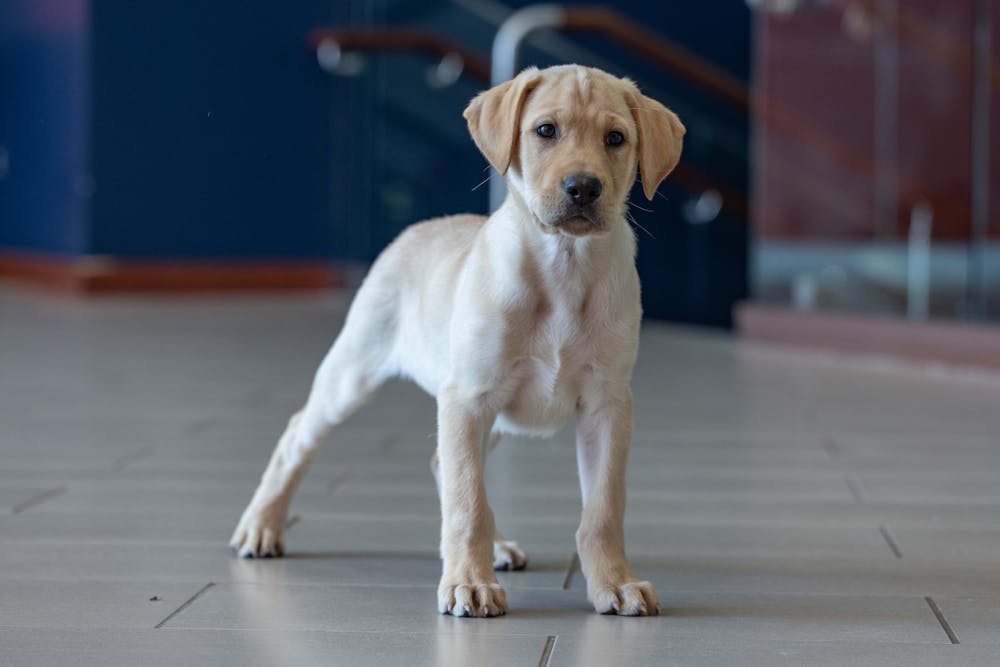The College of Veterinary Medicine’s Canine Performance Sciences Program works “nose to tail” to generate top-of-the-class working dogs. Leading the advancement of canine detection for over thirty years, the program’s history and extensive training both began with the breeding and development of exceptional canines.
According to Assistant Director of CPS Melissa Singletary, the roots of CPS can be traced to the 2001 opening of the dedicated breeding program for purpose-bred detection dogs after Australian customs gifted Auburn University breeding Labradors. Auburn University was the only academic institution out of two other governmental agencies to receive the gift.
Since 2001, CPS has primarily worked with Labrador retrievers from the United States, especially those commonly used for hunting like the sporting and upland game lines.
“We're not only trying to actually breed for high quality dogs, but we're also trying to do sustainable breeding that is of the best health and welfare for those dogs,” Singletary said.
A key part of the CPS mission is producing dogs that are healthy in addition to their skills. The dogs must pass an extensive screening process, ensuring they do not have any concerning genetic conditions that could be passed within their lineage.
After working as a military veterinarian, Singletary returned to Auburn for her doctorate in neuroscience with a focus on olfaction, which is the sense of smell. Due to her passion for military working dogs, Singletary became involved with CPS, providing the program with her knowledge of health, wellness and a foundational neuroscience of the canine sensory systems.
“It's just been a great way for me, personally, to be able to stay a part of the community that I served while I was active duty, as well as engaging with law enforcement and detection dog communities,” Singletary said.
Singletary described the holistic approach CPS uses as working "nose to tail," so that they can learn to what degree the environment, which includes the temperature of the physical environment and the types of tasks canines are assigned, impacts a working dog.
For example, a dog’s anatomy may enable them to perform certain tasks better for a longer duration when compared to other breeds. Also, depending on what they are trained to find, detection dogs may be exposed to various types of odors that may impact their success.
From psychology and behavior to neurology and biophysics, CPS explores many fields to better understand how to maximize a working dog’s capabilities and performance, in regards to their environment.
CPS is broken up into three divisions: breeding and development, basic science and neuroscience and fundamental and molecular neuroscience. According to Singletary, the breeding program enables most of the program’s additional research.
Bart Rogers, chief canine instructor for the breeding and development side of CPS, oversees the training and development of the puppies from their birth to 12 months of age as well as the selection process of breeding in terms of phenotype selection.
During early development when puppies are zero to seven weeks old, adjusting dogs to different sights, sounds, smells and textures is highly important because a working dog must be comfortable working in any environment.
Whether the dog is working in the bustling crowds of Times Square on New Years Eve or a silent forest, Rogers explained a dog must be focused on their work and show no hesitation.
According to Rogers, an environmentally sound dog is produced by a combination of the selection of genetic traits of highly environmentally resilient dogs and the development of those traits to maximize a dog's potential.
Rogers explained that it is important to keep development fun for the puppies so they are not working, but rather they are simply playing.
The puppies work in a stimulation room to explore different tactile, auditory and visual stimulations which can include a disco ball or an adventure box with paint brushes and paint cans. What the puppies view as playtime is actually an exposure tool priming them for later developmental stages.
“[At this stage,] they don't have fear. They have reactivity, but there's no emotion attached to it,” Rogers said. “If I minimize that reaction and increase the recovery to a stimulus, then I am closing a gap, hopefully for when they come out of this window and emotion shows up, fear, that's less of a window for it to creep in and be associated when they see a stimulus."
In addition to a lack of fear, development encourages working dogs to use their judgment in decision-making once they leave the program, even if it opposes their handler’s instructions.
“His handler doesn't know. [The dog is] the detective. So he has to display what we call intelligent disobedience,” Rogers said. “We're building confidence. He's got to carry the hammer. He has to make the decisions. He has to have that independence.”
Rogers explained that after one year in the program, around 80% of dogs are operationally relevant and typically placed with governmental agencies working in narcotics or bomb detection. Only around 10% of the weaker dogs stay at Auburn for future research before being adopted as a pet.
A dog’s transition from CPS to placement with a handler can be the most challenging part for some dogs because they have to get acclimated to a new home life.
Canine detection dogs from Auburn can be spotted across the world working in places such as the Atlanta Airport and South Africa, or at events like the Super Bowl and the Thanksgiving Day Parade.
“Especially Atlanta, I run into my dogs,” Rogers said. “I've had them find me, and had to tell them, I have nothing. He knows me, like out of thousands of people, smells me years later.”
Those interested in learning more about becoming a CPS volunteer who helps care for the canines can contact cvmcps@auburn.edu.
Do you like this story? The Plainsman doesn't accept money from tuition or student fees, and we don't charge a subscription fee. But you can donate to support The Plainsman.
Jennifer Santiago, sophomore double majoring in political science and history, has been with The Auburn Plainsman since the fall of 2024. Santiago previously served as a news writer, and she is currently serving as the Lifestyle Editor.





